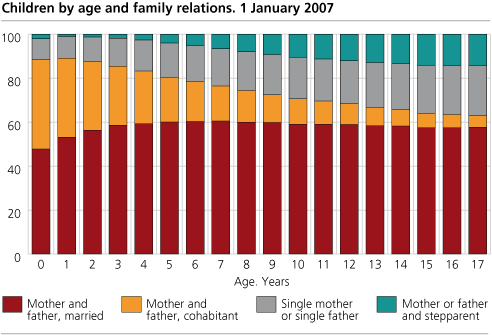Content
Published:
This is an archived release.
Three out of four children live with both parents
At the turn of this year, three out of four children in Norway below 18 years of age lived with both parents. Thus, one out of four lived with just one of the parents. But among these children, one third also lived with a step mother or step father.
As of 1 January 2007, 1 085 800 children below 18 years of age lived in Norway, constituting some 23 per cent of the population. Of these, 17 per cent had cohabiting parents. Among those living with both of their parents, the proportion having cohabiting parents has increased, while the proportion having married parents has decreased.
The highest proportion of children living with married parents is found in the Agder counties and in Rogaland, and the largest proportion having cohabiting parents lived in the Trøndelag counties and in Nordland. Finnmark county had the highest proportion of children living with only one of the parents.
Two out of ten children live without siblings
At the turn of the year, 18 per cent of the children did not live with any siblings. 44 per cent lived with one sibling, 28 per cent with two and 10 per cent with three or more siblings. The highest proportion of those living without any siblings, could be found in Oslo, the lowest proportion in Sogn og Fjordane county. Among children living with both of their parents, 87 per cent had siblings living at home, while the corresponding percentage for children living with only one of the parents was at 68.
More younger than older children have cohabiting parents
In relative terms, most children below the age of one had cohabiting parents, at 41 per cent. Among children five years of age, 20 per cent had cohabiting parents. The proportion gradually decreases as the children grow older, and among those 17 years of age, only five per cent were living with cohabiting parents. There are many reasons for this. Most importantly, it was less common 17 years ago to live in cohabitation, it was more common to marry. Furthermore, many cohabiting parents choose to marry as the children grow older. Moreover, many children experience that their parents separate.
|
In child statistics, children are defined as persons aged 0-17 years, being registered as resident together with at least one of their parents. Persons aged 0-17 years registered as moved away from home, are therefore not included in this statistics. Persons who married or gave birth before turning 18 years, are likewise not included. In register based statistics, the place of residence is based upon the address or residence as stated in the National Register, whereas in sample surveys the respondent herself gives the actual place of residence. Empirically, the number of cohabitants based on register counts will be well below what results from field surveys. According to Population and Housing Census 2001, there were 204 000 cohabiting couples of opposite sex, whereas field surveys from the same year estimated the number of cohabiting couples at approximately 250 000. Hence, the proportion of children with cohabiting parents in register based statistics will be lower than in statistics based on field surveys, while the proportion of children living with only one of their parents will be higher. |
Tables:
- Table 1 Children 0-17 years, by number of parents in the family, the parents' cohabitation arrangements and the child's age. 2001, 2005, 2006 and 2007. Per cent
- Table 2 Children 0-17 years, by number of parents in the family, the parents' cohabitation arrangements, siblings living at home and the child's age. 2001, 2005, 2006 and 2007
- Table 3 Children 0-17 years, by number of parents in the family, the parents' cohabitation arrangements and county. 2001, 2005, 2006 og 2007. Per cent
- Table 4 Children 0-17 år, by type of siblings living at home and the child's age. 2001, 2005, 2006 and 2007. Per cent
- Table 5 Children 0-17 år, by type of siblings living at home and county. 2001, 2005, 2006 and 2007. Per cent
- Table 6 Children 0-17 years, by number of siblings and parents living at home and the parents' cohabitation arrangements. 2001, 2005, 2006 and 2007. Per cent
- Table 7 Children 0-17 years, by number of siblings and county. 2001, 2005, 2006 and 2007. Per cent
- Table 8 Children 0-17 years, by number of siblings and the child's age. 2001, 2005, 2006 and 2007. Per cent
The statistics is published with Families and households.
Contact
-
Statistics Norway's Information Centre
E-mail: informasjon@ssb.no
tel.: (+47) 21 09 46 42

